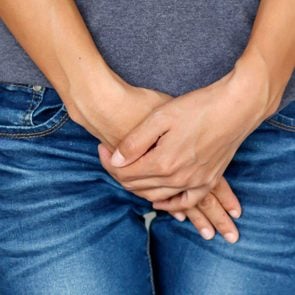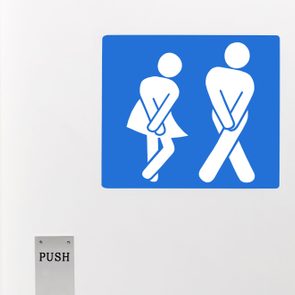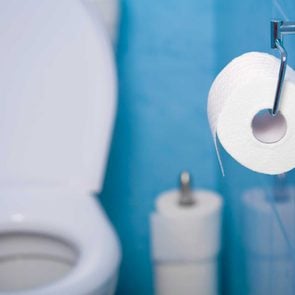Do You Pee When You Sneeze? Here’s How to Stop It
Updated: Jul. 27, 2021
If you pee when you sneeze, it may be due to stress incontinence. Here's what experts say about the symptoms and treatments.
Stress incontinence 101
Do you pee when you sneeze? How about when you laugh, cough, or lift something heavy?
If so, you are not alone, says Elizabeth Kavaler, MD, a urologist at Lenox Hill Hospital in New York City.
These are symptoms of stress urinary incontinence, which affects as many as one in three women at some point in their lives, according to the American Urological Association.
It occurs when urine leaks out due to sudden pressure on the bladder and urethra, the tube that moves urine out of your bladder. It’s more common in women than men because anatomically, they have shorter urethras.
The problem may start when you sneeze, but left untreated, urine may begin to leak with less forceful activities like standing up, walking, or bending.
The greater the pressure, the more likely you are to leak, Dr. Kavaler says. And sneezing produces a lot of pressure.
It’s not the same thing as an overactive bladder or urge incontinence, she adds.
“With stress incontinence, there is a mechanical pressure that results in squirting,” Dr. Kavaler explains. By contrast, urge incontinence is marked by a sudden and overwhelming ‘gotta-go’ feeling.
“You put the key in the door and still can’t make it to the bathroom,” she notes. Women can have both forms of incontinence at the same time.
Here’s everything you need to know about why you pee when you sneeze, diagnosing the issue, and treatment options.

So, why do I pee when I sneeze?
What gives? The short answer is your pelvic floor.
Your pelvic floor supports your bladder and urethra, and stretching or damaging it increases your risk for stress incontinence.
Lots of things can affect your pelvic floor, including pregnancy, childbirth, surgeries in and around this area, chronic coughing, smoking, connective tissue diseases such as lupus, hormonal changes, nerve injuries, and being overweight or obese.
“As one ages, all sorts of factors contribute to developing stress incontinence,” Dr. Kavaler says.
It’s more common in women, but men can also develop stress urinary incontinence, especially after prostate surgery.
Ask a doctor about symptoms
Several types of doctors can diagnose and treat stress incontinence, including urologists, gynecologists, urogynecologists, and internists, Dr. Kavaler says. Urogynecologists super specialize in pelvic floor disorders.
If you are leaking, speak up, especially if your doctor doesn’t ask, says Melissa Laudano, MD, a urologist, and urogynecologist at Montefiore Health System and an assistant professor, urology and of obstetrics and gynecology at the Albert Einstein College of Medicine in New York.
“There is no reason to be embarrassed. This is so common and highly treatable,” she says.
Tests for stress incontinence
Some tests can help determine what’s going on, she says. “I will ask, ‘do you leak when you cough, sneeze or exert yourself?'” she says.
“If the answer is yes to any of these questions, it puts you in the stress urinary incontinence realm.”
Your doctor will conduct a physical exam with a focus on the organs in your pelvic floor.
Other tests involve coughing or bearing down with a full bladder. This is the ‘cough stress test’ and helps identify leakage on exam, Dr. Laudano says.
Pad tests may be recommended to see if you leak when you move around. There are two types: a one-hour test and the 24-hour test. After the test, the pad is removed and weighed to see how much urine leaked.
Other tests may help rule out any other potential causes of the leaking, including a urinalysis check for a urinary tract infection or blood in the urine or a bladder scan, Dr. Laudano explains.
Stress incontinence treatment
First things first, and that means experts recommend that you first try behavioral and lifestyle changes, such as fluid restriction and timed-voiding.
Timed-voiding—going to the bathroom at specific intervals rather than when you feel the need to go—can help keep your bladder from becoming too full, Dr. Kavaler says.
A typical schedule would be to take bathroom trips first thing in the morning, at least every two hours when you are awake, and once again before bed, but your doctor will determine what schedule is best for you.
Timed voiding is more effective for overactive bladder than stress incontinence, says Marisa Clifton, MD, associate professor (PAR) of urology and the director of women’s health at the Brady Urological Institute at Johns Hopkins Medicine in Baltimore, Maryland.
“It’s common for women to have a little stress and a little overactive bladder, and in this case, we treat the more bothersome one first,” she says.
It’s also wise to stay away from bladder irritants such as coffee, tea, and juices.
(Here are some things your bladder is trying to tell you.)
Do your Kegels
These are pretty easy once you get the hang of them, Dr. Laudano says. Kegels call for squeezing and then relaxing your pelvic floor muscles so they are better able to hold urine.
A pelvic floor physical therapist can help learn how to properly perform Kegels to help with stress urinary incontinence.
There’s no magic number of how many Kegels you should do and how often.
“A good rule of thumb is to do eight to twelve contractions, holding for up to 10 seconds, and relaxing in between for one to two seconds and repeat these three times a day for six months,” she says.
Kegels only work if you do them, and do them consistently, according to Dr. Laudano.
Lose weight
Shedding even just a few pounds can improve both urge and stress urinary incontinence symptoms, says Dr. Clifton.
“Increased weight can irritate the bladder and put additional pressure on it, causing symptoms,” she says.
(Here are 50 easy ways to lose weight naturally.)
Incontinence devices
If lifestyle and behavioral changes don’t make a dent in your symptoms, you can try incontinence devices, such as a pessary, a flexible device that inserts into your vagina to better support the urethra, or disposable tampon-like devices, namely Poise’s Impressa.
“Impressa is ideal for women who run marathons, and that is the only time they have leakage due to stress incontinence,” Dr. Clifton says. (Leak during exercise? These nine ways can make it stop.)
These devices aren’t cures, but they can stop your leaks before they start and are especially helpful if you don’t want surgery for stress incontinence, she says.
“We don’t have any medications that we can use for stress incontinence,” she adds.
Bulking injections
Next up are injections that bulk up your urethra head to prevent leakage, she explains.
There are many types of bulking agents that can be used for these procedures. The newest, Bulkamid, is biocompatible with your body and shows great promise in terms of improving stress incontinence, she says.
Doctors give these injections in their office using local anesthesia.
“They can be a cure, but there is a portion of patients who need to have more treatments afterward,” Dr. Clifton says.
“We don’t have any medications that we can use for stress incontinence,” Dr. Clifton adds.
Surgery
If you are looking for a more permanent fix, sling surgeries that use either mesh or your own tissue can create a sling under your urethra or bladder neck.
The sling supports the urethra and helps keep it closed when you cough or sneeze, Laudano says. This is a cure, she says.
It’s not for every woman, though. “If you are considering children and planning a vaginal birth, these surgeries are not ideal,” she says.
“We want to rule out any other conditions before bulking or sling surgery,” Dr. Clifton says. This typically includes a post-voiding check to make sure that your bladder is empty.
“If you are not emptying and leaking urine off of the top, we would treat it differently.”
Not everyone chooses to treat stress incontinence—and nothing will happen if you learn to live with the leakage.
But the benefits in terms of quality of life are not an overstatement, Dr. Clifton says.
“When patients have a good outcome, they say, ‘I wish I would have done this sooner,” she says.
“If you are not going out and doing activities you love or feel embarrassed, these are indications that you need to consider therapy.”
Next, check out if it’s OK to pee in the shower.



















